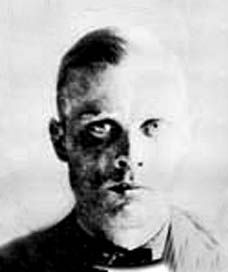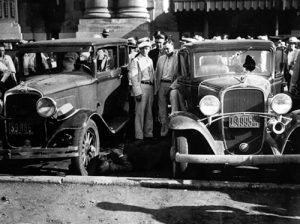Vernon C. Miller was a freelance Prohibition gunman, bootlegger, bank robber, and former sheriff in South Dakota.
Miller was born in Kimball, South Dakota, on August 25, 1896. In 1914, he moved 35 miles northeast to Huron, South Dakota, where he began working as an auto mechanic. Two years later, he enlisted in the U.S. Army and saw action on the Mexico border during repeated bandit raids. When World War I began, he served in France and was decorated for valor and bravery, rising to the rank of sergeant by the war’s end. When the war ended, he returned to Huron, where he joined the police force in 1918. Two years later, he ran for Beadle County Sheriff and won the election in November 1920. However, somewhere along the line, he decided that a life of law enforcement didn’t fit with him and absconded with $4,000 in county funds.
He was later tracked down and convicted of embezzlement on April 4, 1923. Incarcerated in the South Dakota State Penitentiary, he didn’t serve long, being paroled in November 1924.
By this time, Prohibition was in full force and effect, and Miller entered the bootlegging trade. He was fined for bootlegging in Sioux Falls, South Dakota, in October 1925 but continued the lucrative trade. Miller then moved to St. Paul, Minnesota, and Chicago, Illinois, where he began associating with underworld gangs. Coming into contact with many unscrupulous characters, he soon became a freelance gunman for several Midwest bootleggers and racketeers. He was indicted on February 3, 1928, for the murder of a Minneapolis police officer, but the case was dropped for lack of evidence.
In 1930, after Al Capone’s men killed a friend of his, Miller tracked down three suspects and gunned them down in June in what later became known as the Fox Lake Massacre. That same year, he teamed up with other gangsters — Harvey Bailey, Thomas Holden, Francis Keating, George “Machine Gun” Kelly, and three others in a daylight raid resulting in the theft of $70,000 from a bank in Willmar, Minnesota, on July 15, 1930. Less than a month later, on August 13, in an argument over a “double-cross” from the bank robbery, Miller killed Frank “Weinie” Coleman, Mike Rusick, and “Jew” Sammy Stein and dumped their bodies at White Bear Lake. The following month on September 9, 1930, Miller participated with Bailey, Holden, Keating, Kelly, and Lawrence De Vol in stealing $40,000 from a bank in Ottumwa, Iowa. The following year, with Bailey, Kelly, Frank “Jelly” Nash, and several others, he robbed a bank in Sherman, Texas, of $40,000 on April 8, 1931. He reportedly was involved in killing two Minneapolis Police Officers in December 1932.
He then returned to primarily acting as a hired gunman and was hired to free former partner Frank Nash from federal custody. On the morning of June 17, 1933, Miller and Charles “Pretty Boy” Floyd and Adam Richetti attempted to free Nash while he was transported to Leavenworth Federal Prison. As Nash was escorted from the Union Train Station in Kansas City, Missouri, the outlaws opened fire in the escape attempt. In the end, Nash and four lawmen were killed in what has become known as the Kansas City Massacre.
Following the Kansas City Massacre, Miller, accompanied by his girlfriend, Vivian Mathias, traveled to Chicago, arriving about June 19, 1933. For a few days, he hid with a member of the Barker-Karpis gang. From there, he then reportedly went to New York. On October 31, 1933, an FBI investigation discovered he was back in Chicago with his girlfriend. The next day, he escaped a trap set for him by the FBI. However, Mathias was taken into custody and later pleaded guilty to harboring and concealing a fugitive.
On November 29, 1933, as the FBI continued to search for Miller, his mutilated body was found in a ditch on the outskirts of Detroit, Michigan. He had been beaten and strangled. Information later received by the FBI indicated that Miller had been involved in an altercation with a henchman of Longie Zwillman, head of New Jersey’s underworld mob, in Newark. During the dispute, Miller shot the henchman, and a short time later, another Zwillman associate reportedly retaliated by killing Miller.
© Kathy Alexander/Legends of America, updated June 2023.


